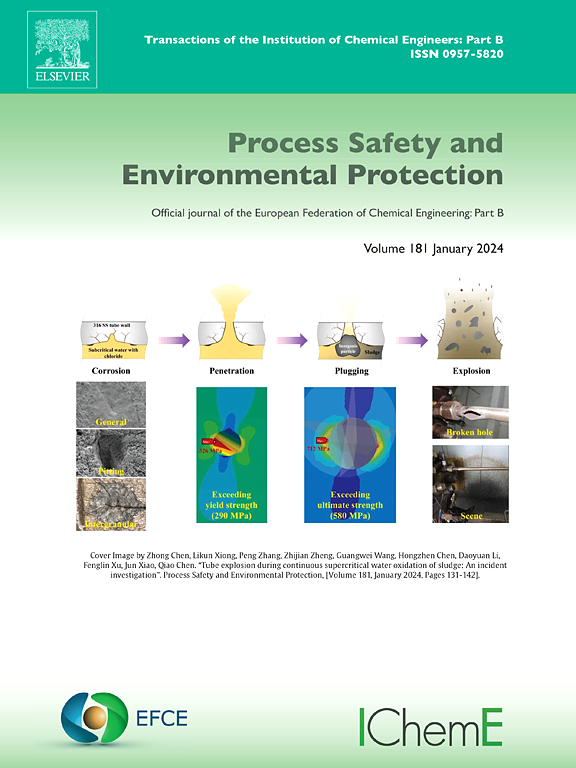Intelligent identification of internal leakage in natural gas pipeline control valves based on Mamba-ARN
IF 7.8
2区 环境科学与生态学
Q1 ENGINEERING, CHEMICAL
引用次数: 0
Abstract
Natural gas pipeline control valves are widely used in industrial and civil fields. However, in actual operation, due to factors such as wear, tiny sealing defects may occur between the valve core and the valve seat, leading to natural gas leakage. The complex application environment makes the vibration signal often affected by noise and background factors, which reduces the signal quality and thus affects the accuracy of diagnosis. To address this problem, this study proposes a lightweight intelligent fault diagnosis method based on Mamba Attention Residual Network (Mamba-ARN). The methodology converts one-dimensional vibration signals into a time-frequency feature map using continuous wavelet transform (CWT), which is fed into the Mamba-ARN model for leak detection. To enhance the model's performance, it integrates a residual network structure, ECA and CBAM attention mechanisms, Swish activation functions, and CutMix data augmentation. The main contributions of this method include: (1) By combining Mamba, ECA, CBAM modules and Bottleneck structure, the model can adaptively enhance the feature expression ability, improve the accuracy of feature selection and extraction, reduce computational complexity, and enhance robustness and training stability; (2) The use of Swish activation function and CutMix data augmentation technology not only improves the computational efficiency and stability of the model, but also significantly improves the generalization ability of the model by increasing data diversity, and verifies its versatility and robustness under complex working conditions through transfer tasks under different noise conditions. Experimental results show that the accuracy of the model in the internal leakage recognition task reaches 99.8 %, which is significantly better than the other eight mainstream comparison methods (CNN: 96.9 %, CNN-LSTM: 83.52 %, Transformer: 93.9 %, ResNet-18: 97.9 %, CNN-Transformer: 95.2 %, Mamba-SE: 98.7 %, Mamba- Non-local: 97.8 %, Mamba-MixUp: 97.6 %), further verifying the generalization ability and stability of this method in complex environments.
基于Mamba-ARN的天然气管道控制阀内泄漏智能识别
天然气管道控制阀广泛应用于工业和民用领域。但在实际操作中,由于磨损等因素,阀芯与阀座之间可能出现微小的密封缺陷,导致天然气泄漏。复杂的应用环境使振动信号经常受到噪声和背景因素的影响,从而降低了信号质量,影响了诊断的准确性。针对这一问题,本研究提出了一种基于曼巴注意残差网络(Mamba- arn)的轻量级智能故障诊断方法。该方法利用连续小波变换(CWT)将一维振动信号转换为时频特征映射,并将其输入到Mamba-ARN模型中进行泄漏检测。为了提高模型的性能,它集成了残差网络结构、ECA和CBAM注意机制、Swish激活功能和CutMix数据增强。该方法的主要贡献包括:(1)通过结合Mamba、ECA、CBAM模块和瓶颈结构,模型能够自适应增强特征表达能力,提高特征选择和提取的准确性,降低计算复杂度,增强鲁棒性和训练稳定性;(2)利用Swish激活函数和CutMix数据增强技术,不仅提高了模型的计算效率和稳定性,而且通过增加数据多样性,显著提高了模型的泛化能力,并通过不同噪声条件下的传递任务验证了模型在复杂工况下的通用性和鲁棒性。实验结果表明,模型的准确性在内部泄漏识别任务达到99.8 %,明显比其他八个主流比较方法(CNN: 96.9 %,CNN-LSTM: 83.52 %,变压器:93.9 %,ResNet-18: 97.9 %,CNN-Transformer: 95.2 %,Mamba-SE: 98.7 %,曼巴-非本地:97.8 %,Mamba-MixUp: 97.6 %),进一步验证该方法的泛化能力和稳定性在复杂的环境中。
本文章由计算机程序翻译,如有差异,请以英文原文为准。
求助全文
约1分钟内获得全文
求助全文
来源期刊

Process Safety and Environmental Protection
环境科学-工程:化工
CiteScore
11.40
自引率
15.40%
发文量
929
审稿时长
8.0 months
期刊介绍:
The Process Safety and Environmental Protection (PSEP) journal is a leading international publication that focuses on the publication of high-quality, original research papers in the field of engineering, specifically those related to the safety of industrial processes and environmental protection. The journal encourages submissions that present new developments in safety and environmental aspects, particularly those that show how research findings can be applied in process engineering design and practice.
PSEP is particularly interested in research that brings fresh perspectives to established engineering principles, identifies unsolved problems, or suggests directions for future research. The journal also values contributions that push the boundaries of traditional engineering and welcomes multidisciplinary papers.
PSEP's articles are abstracted and indexed by a range of databases and services, which helps to ensure that the journal's research is accessible and recognized in the academic and professional communities. These databases include ANTE, Chemical Abstracts, Chemical Hazards in Industry, Current Contents, Elsevier Engineering Information database, Pascal Francis, Web of Science, Scopus, Engineering Information Database EnCompass LIT (Elsevier), and INSPEC. This wide coverage facilitates the dissemination of the journal's content to a global audience interested in process safety and environmental engineering.
 求助内容:
求助内容: 应助结果提醒方式:
应助结果提醒方式:


